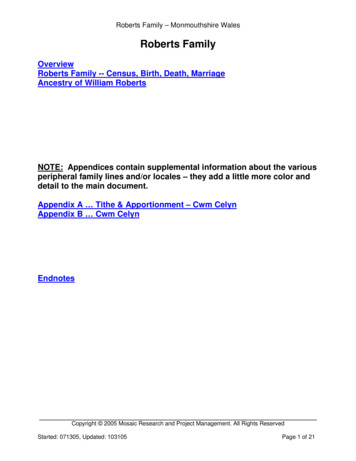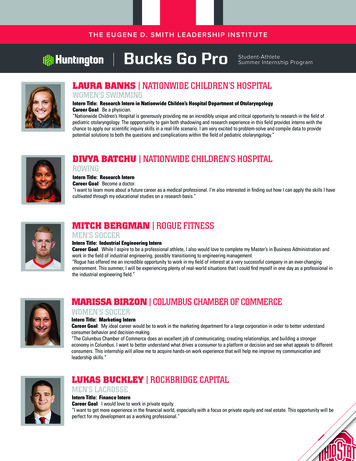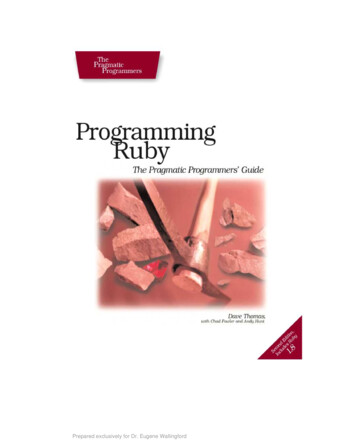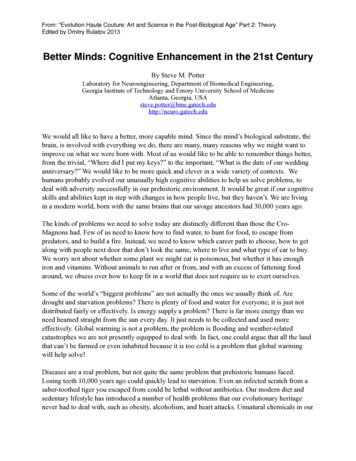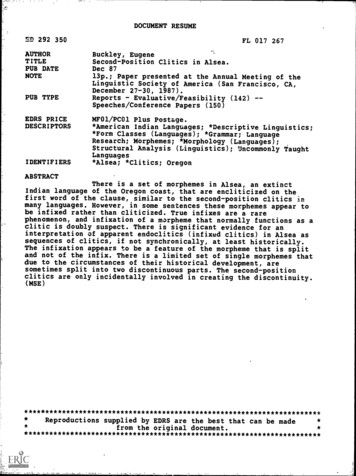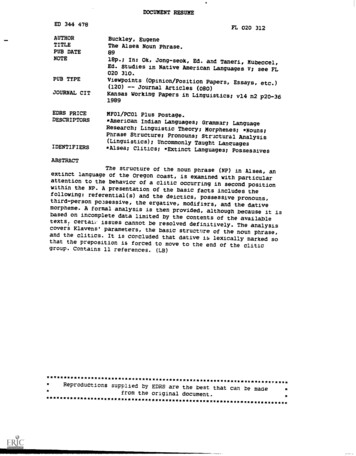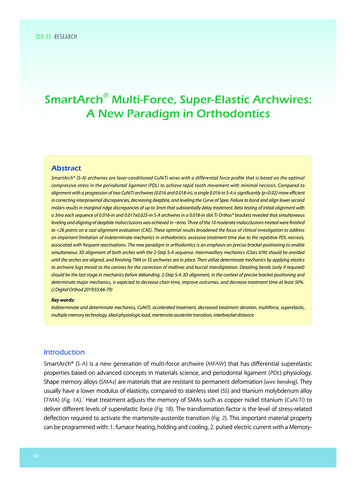
Transcription
JDO 55 RESEARCHSmartArch Multi-Force, Super-Elastic Archwires:A New Paradigm in OrthodonticsAbstractSmartArch (S-A) archwires are laser-conditioned CuNiTi wires with a differential force profile that is based on the optimalcompressive stress in the periodontal ligament (PDL) to achieve rapid tooth movement with minimal necrosis. Compared toalignment with a progression of two CuNiTi archwires (0.016 and 0.018-in), a single 0.016-in S-A is significantly (p 0.02) more efficientin correcting interproximal discrepancies, decreasing deepbite, and leveling the Curve of Spee. Failure to bond and align lower secondmolars results in marginal ridge discrepancies of up to 3mm that substantially delay treatment. Beta testing of initial alignment witha 3mo each sequence of 0.016-in and 0.017x0.025-in S-A archwires in a 0.018-in slot Ti Orthos brackets revealed that simultaneousleveling and aligning of deepbite malocclusions was achieved in 6mo. Three of the 10 moderate malocclusions treated were finishedto 26 points on a cast alignment evaluation (CAE). These optimal results broadened the focus of clinical investigation to addressan important limitation of indeterminate mechanics in orthodontics: excessive treatment time due to the repetitive PDL necrosis,associated with frequent reactivations. The new paradigm in orthodontics is an emphasis on precise bracket positioning to enablesimultaneous 3D alignment of both arches with the 2-Step S-A sequence. Intermaxillary mechanics (Class II/III) should be avoideduntil the arches are aligned, and finishing TMA or SS archwires are in place. Then utilize determinate mechanics by applying elasticsto archwire lugs mesial to the canines for the correction of midlines and buccal interdigitation. Detailing bends (only if required)should be the last stage in mechanics before debonding. 2-Step S-A 3D alignment, in the context of precise bracket positioning anddeterminate major mechanics, is expected to decrease chair-time, improve outcomes, and decrease treatment time at least 50%.(J Digital Orthod 2019;55:66-79)Key words:Indeterminate and determinate mechanics, CuNiTi, accelerated treatment, decreased treatment deration, multiforce, superelastic,multiple memory technology, ideal physiologic load, martensite-austenite transition, interbracket distanceIntroductionSmartArch (S-A) is a new generation of multi-force archwire (MFAW) that has differential superelasticproperties based on advanced concepts in materials science, and periodontal ligament ( PDL) physiology.Shape memory alloys (SMAs) are materials that are resistant to permanent deformation (wire bending). Theyusually have a lower modulus of elasticity, compared to stainless steel (SS) and titanium molybdenum alloy(TMA) (Fig. 1A).1 Heat treatment adjusts the memory of SMAs such as copper nickel titanium (CuNiTi) todeliver different levels of superelastic force (Fig. 1B). The transformation factor is the level of stress-relateddeflection required to activate the martensite-austenite transition (Fig. 2). This important material propertycan be programmed with: 1. furnace heating, holding and cooling, 2. pulsed electric current with a Memory-66
SmartArch Multi-Force, Super-Elastic Archwires JDO 55Dr. W. Eugene Roberts,Indianapolis, Indiana (Left)Dr. Jeffery A. Roberts,Indianapolis, Indiana (Center left)Dr. Stephen Tracey,Upland, California (deceased) (Center right)Dr. David M. Sarver,Vestavia Hills, Alabama (Right) Fig. 1:A. Shape memory alloys have a uniform initial modulus of elasticity and are resistant to permanent deformation. When loaded into thesuperelastic range, the unloading curve is relatively uniform for a given plateau of force. Titanol is a trademark for Forestadent (Pforzheim,Germany). See text for details.B. Modification of the superelastic transition zone with heat treatment produces unloading curves with variable levels of unloading force.These illustrations are modified versions from an original article published by the senior author (WER).1 Fig. 2:The level of stress (wire deformation) to enter the martensite-austenite transition zone is adjusted with heat treatment. This is a copy of apresentation slide explaining the concept relative to Md arch alignment in 3D. This illustration is a modification from an original articlepublished by the senior author (WER).167
JDO 55 RESEARCHMaker ( Forestadent, Pforzheim, Germany ), 1 or 3.there must be no more than two abutments: teeth,pulsed fiber laser conditioning ( Smarter Alloys ,arches or segments. 5,7,9,10 Any device (archwires orWaterloo ONT Canada).2 The latter method is thepatented multiple memory material (MMM) concept( Fig. 3 ). MMM technology can precisely programaligners) engaging multiple teeth at once is staticallytransition zones as narrow as 0.001-in in a cross-in PDL necrosis that delays tooth movement andsection of SMA wire. At least 10 levels of superelasticinduces root resorption every time the mechanicsunloading profiles can be programmed into aare reactivated.5,6,11 The ideal physiologic force forsingle CuNiTi archwire (Fig. 4). S-A is manufacturedeach tooth is based on interbracket distance, and theindeterminate. Loads are transferred throughout theperiodontium in an unknown manner,5,6 resultingaccording to specific PDL compressive stress values,derived from finite element analysis (FEA) of digitaldental templates exposed to four types of toothmovement ( Fig. 5 ). 4 The S-A archwires currentlyon the market (Ormco, Brea CA ) are made for theaverage human dentition. However, with cone-beamcomputed tomography (CBCT) data, S-A archwirescan be custom manufactured for specific arches andApatients.Fig. 4:A presentation slide illustrates the MMM technology developedby Ibraheem Khan et al.2,3 to produce Smart-Arch archwires.Variable interbracket distances are shown on the left (A). The lowerright illustration depicts mechanical stress in the PDL (C). Thesecritical PDL physiologic parameters were unknown when themanufacturing technology was developed. See text for details. Fig. 5:PDL stress was defined by Rodrigo Viecilli4,11 with FEA for each toothin the mouth except third molars. The optimal archwire force forfour types of tooth movement was calculated to produce adequatePDL stress to move a tooth without inducing necrosis. See text fordetails.determinate and indeterminate mechanics.5-10 Thedeterminate approach is more predictable becauseall the 3D forces and moments are known. However,68Fig. 3:Smart-Arch technology and its clinical applications are summarizedin a presentation slide.C Orthodontics is accomplished with both B
SmartArch Multi-Force, Super-Elastic Archwires JDO 55average PDL compressive stress (P3) calculated with0.016-in round, and 0.018x0.025-in (0.022-in slot) or4FEA for four types of tooth movement (Figs. 5 and 6).0.017x0.025-in (0.018-in slot) rectangular archwiresThe S-A force profile is based on ideal physiologicare efficient for initial alignment and levelingloads, which are not achieved with common initialwithout presenting any unusual risks to the patients.alignment archwires such as 0.014-in CuNiTi, andthe previous generation of MFAW (Tri-Force , G&HOrthodontics, Franklin IN or similar), a GAC-Dentsply(Harrisburg PA) product that is now out of patent.Figure 7 illustrates the relative force levels per toothin a panoramic view of the maxillary arch. The inseton the upper right (blue background) shows a colorcoded view of the superelastic levels programmedinto the interbracket segments of a maxillary S-Aarchwire (Fig. 7). S-A archwires are a unique concept in orthodonticmechanics ( Fig. 8 ). They deliver physiologicallyoptimized loads for an extended period of time.This advance in orthodontic materials helps controlthe indeterminate mechanics, and repetitiveFig. 7:Three types of initial archwires are illustrated. 0.014-in CuNiTiis a uniform material that delivers variable force depending oninterbracket distance. Tri-Force TM is a first generation MFAWthat produces progressively increasing force from the canine tothe second molar. S-A is programmed to fit the ideal force curvederived by Viecilli (Fig. 5). The color-coded drawing on the upperright shows multiple superelastic force levels programmed into theinterproximal segments of a maxillary S-A archwire.archwire reactivations that lengthen treatment andcompromise outcomes. It is hypothesized that S-ASMART-ARCH : A UNIQUE CONCEPTSpeciÞc mechanics for malocclusion correction with only two archwires:1. .016Ó Round: simultaneous alignment and leveling2. .018x.025Ó Rectangular: optimal third order correction Fig. 6:S-A is a modified CuNiTi archwire that was differentially temperedto deliver the ideal physiologic load for each tooth, as previouslycalculated by Viecilli (Fig. 5). Neither 0.014-in CuNiTi nor a 0.016-inTri-ForceTM archwires comply. See text for details.Fig. 8:Smart-Arch is a unique archwire concept that is available in a0.016-in round and 0.018x0.025-in rectangular configurations.The 2-Step 3D alignment procedure utilizes each wire for 3mo toresolve a Class I malocclusion. Class II or III problems are correctedwith determinate mechanics by applying elastics to lugs on thearchwires mesial to the canines. See text for details.69
JDO 55 RESEARCHMaterials and MethodsAll clinical records were retrospectively sourcedfrom private practices with an industrial InstitutionalReview Board ( IRB ) approval: Solutions IRB.com,#Protocol 2019/01/18. Inclusion criteria: 1. routine malocclusionsrequiring full fixed appliances in both arches,2. late mixed or permanent dentition, 3. initialalignment accomplished with a S-A archwire,and 4. no additional mechanics such as bracketrepositioning or intermaxillary elastics.Study 2. Treatment was identical to Study 1 exceptthe brackets were 0.018-in Ti Orthos (Ormco, BreaCA), and both arches were aligned with 0.016-in S-A.The treatment times were 143.0 34.1 (range 60-180)days. The retrospective clinical records were castsand intraoral photographs at the start and finish, aswell as intraoral photographs when progress wasevaluated.Study 3. Treatment and records sourced wereidentical to Study 2 except the initial alignmentsequence was 0.016-in CuNiTi for 3mo followed by0.018-in CuNiTi for 3mo, and the treatment time Exclusion criteria: 1. craniofacial anomalies,was uniform for all patients ( 180 days ). Progress2. missing more than four permanent teeth,photographs and thermoplastic bite registrations3. periodontal compromise, and 4. treatmentwere collected at varying intervals when patientsinvolving orthognathic surgery. With the patient’presented for evaluation. This was an independents permission (and parent if a minor), deidentifiedstudy conducted by two of the authors (WER, DMS),casts and intraoral photographs (start and finish)and submitted for publication.6 It was not supportedwere sourced along with intraoral photographsor controlled by any commercial interests.at variable intervals when the patients wereseen during the initial alignment process.Study 1. The lower arch was initially aligned with asingle 0.016-in S-A archwire in 0.022-in slot DamonQ brackets (Ormco, Brea CA). Two of the authors, JAR(Indiana) and ST (California) submitted deidentifiedcasts and intraoral photographs for 7 and 6 patients,respectively. The collective treatment times were128.5 34.2 (range 72-190) days. S-A archwires wereremoved when sufficient alignment was achievedto progress to the next archwire. There were nocasts, so all measurements were made on intraoralphotographs and thermoplastic bite registrations(Heat & Bite , Ormco, Brea CA).Study 4. Ti Orthos brackets ( 0.018-in slot ) werebonded on both arches of 10 consecutive, routinemalocclusions. Initial leveling and alignment in3D was accomplished with 0.016-in S-A for 3mofollowed by a 0.017x0.025-in S-A for 3mo. A castsonly discrepancy index (C-O DI) was performed atthe start of treatment. The method is identical to theAmerican Board of Orthodontics (ABO) DiscrepancyIndex (DI) except there is no radiographic analysis(cephalometrics).6 Cast Alignment Evaluations (CAE)were performed at the end of each stage of thealignment phase. The CAE is similar to the ABO castradiograph evaluation ( CRE ) except it is a castsonly method with no evaluation of a panoramicradiographs.670
SmartArch Multi-Force, Super-Elastic Archwires JDO 55Records Assessment: The interproximal discrepancyinitial alignment. None of the archwires presentedindex ( IDI ) was the total malalignment for allany unusual risks to patients.marginal ridge discrepancies (MRDs). MRDs betweenmandibular first (L6) and second (L7) molars wereMFAW is the generic term for archwires thatdeemed 7-6 discrepancies. They were measureddeliver variable loads. Smart-Arch (S-A) is a secondseparately on the casts and then summed to simplifygeneration MFAW that delivers differential loads tothe data presentation. In brief, the alignment of allindividual teeth based on physiologically relevanterupted teeth was assessed in 3D on casts, and in 2DPDL stress levels.4 The only uniform aspect of theon photographs. Measurements were made underbeta testing across groups was initial alignmenthigh intensity light at 2x magnification (Opti-Visor of the mandibular arch with 0.016-in S-A. Thosehead-band loupes, Donegan Optical, Lenexa KS) tocomparative data are presented for studies 1-3 inthe nearest 0.5mm with an analog precision caliperTable I, and statistical tests are summarized in Table(Mitutoyo, No. 505-633-50, Kanagawa, Japan), whichII. The IDI was significantly (p 0.001) reduced for allhas a resolution of 0.05mm. Overbite and overjetgroups at 128-180d, as specified (Fig. 9; Tables I andwere measured to the nearest 0.1mm at the startand end of the study with the same caliper. Overjet,II). There was no difference for the final IDI betweengroups, except for studies 3 vs. 1 (p 0.001). A 3mooverbite and curve of Spee ( CoS ) measurementseach sequence for 0.016 and 0.018-in CuNiTi wireswere made on start and finish casts for Studies 2 andin 0.018-in Ti Orthos brackets provided a baseline3. Data were summarized with means and standardreference for routine initial alignment.6 The IDI wasdeviations. Statistical significance was tested withreduced from 11.3 4.2 to 3.9 2.5mm, which isthe paired two-tailed t-test programmed intoa 61.4 26.6% correction in a standardized 6moMicrosoft Excel (Redlands, WA).period ( 180d ). A 0.016-in S-A archwire in same Ti6Orthos brackets was more effective (p 0.03) thanResultsCuNiTI in reducing the IDI from 15.8 6.5 to 2.5 2.7mm, which was a 82.2 19.5% correction inTwo patients, one in Study 1 and another in Study143.0 35.3d. The same S-A archwire in a 0.022-in2, experienced fractures of 0.016-in S-A archwiresDamon Q bracket was even more effective (p 0.01)in the lower posterior segments in the same area:for reducing the initial IDI for severe malocclusionsbetween the second premolars and the first molars.from 21.4 6.4 to 1.1 1.2mm, which was a 94.5 The problems were asymptomatic, and the fractured6.2% correction in 128.5 34.2d ( Fig. 9 ). The timearchwires were replaced within 7d. There were nocourse for initial alignment (Study 2) was comparedproblems with any of the rectangular S-A wires.for the maxillary (Mx) and mandibular (Md) archesThe hypothesis is accepted that S-A archwires, inby separating the progress (124 34d) from the finishthe 0.016-in, 0.017x0.025-in, and 0.018x0.025-in(180d) data. There were no significant differences inconfigurations, provide efficient continuous loads forIDI or percent correction data between the divided71
JDO 55 RESEARCH Table I:Correction of interproximal discrepancies in the lower arch with S-A or CuNiTi (3mo 0.016-in - 3mo 0.018-in) in two types of brackets:0.022-in slot Damon Q , and 0.018-in Ti Orthos .Two-Tailed T-Test for Statistical Significance (p .05)Initial IDIStudy 10.001Study 20.00172% Correction0.001Study 3 Final IDIStudy 1 vs 20.030.100.001Study 2 vs 30.020.110.017Study 3 vs 10.020.0010.001Table II:Statistical comparison of Studies 1-3 was with paired t-tests.Compared to the initial IDI, the final IDI was significantly reduced(p 0.001) in all three studies. The S-A Damon Q group (Study 1)had a significantly greater mean IDI (p 0.03) and were treatedto the highest percent correction (P 0.01), compared to theother groups. Fig. 9:Correction of mandibular interproximal discrepancies with0.016/0.018-in CuNiTi is compared to S-A 0.016-in in Ti Orthos and Damon Q brackets. All of the methods produced significant(p 0.001) decreases in the IDI. However, S-A delivered a significantly(p 0.01) better correction for more complex malocclusions in bothtypes of brackets. See text for details.
SmartArch Multi-Force, Super-Elastic Archwires JDO 55samples. The IDI decreased to a minimal level of1.40mm at progress sampling (124 34d), but thenrelapsed to 5.02mm at the prescribed 180d finish (Fig.10; Table III). Leveling was assessed as the correctionof deepbite (overbite), Curve of Spee (CoS), and Mdfirst and second molar (7-6) MRDs (Fig. 11; Tables IV-VI).Deepbite (overbite) of 3mm was prevalent in boththe MFAW (83.3%) and CuNiTi (70%) samples (TableIV). Overbite was significantly (p 0.001) decreased 2mm with S-A MFAW, but not with CuNiTi leveling.The initial CoS was 0.7mm less (p 0.006) in CuNiTicompared to S-A MFAW patients ( Table V). CuNiTialignment failed to significantly level the lower arch.On the contrary, MFAW (S-A) archwires significantlydecreased the deepbite (p 0.008) and CoS (p 0.001).In addition, there was a nonsignificant ( p 0.11 ) Fig. 10:Correction of interproximal discrepancies in the maxillary (Mx) andmandibular (Md) arches is shown at the start, progress and finish(180d). Note that most patients reach an optimal correction byabout 90d and then relapse. See text for details.6mo Initial Alignment: MFAW (.016" S-A) in.018" Ti OrthosBracketsInitialLower 6.218.6383.9%IDIFinal%TxInitialIDICorrectionTime dIDIUpper ArchFinal%InitialIDICorrectionIDILower ArchFinal%TxIDICorrectionTime %150 289.6%22.2291.0%120n p 7.912.4815.7%6.272.5918.9%34.111.81.6n 1515151515151515p p Upper Arch0.001Upper Arch vs. Lower 086.4%6.5184.6%180Upper Arch vs. Lower Arch19.7954.3%9.6547.9%n 63.3%180SD5.992.6416.2%5.212.9320.2%0.00p Upper Arch vs.Lower Arch0.350.970.71Table III:Six months of initial alignment data is presented for both arches treated with 0.016-in S-A archwires in 0.018-in slot Ti Orthos brackets.73
JDO 55 RESEARCHMFAW (S-A)(S-A) 0.016-in0.016-in 6mo6mo InitialInitial AlignmentAlignmentMFAWDeepbite ofof atat leastleast 3mm:3mm: 15/1815/18 .5664.84.855MeanMeanSDSDTurbosTurbosnnp p p p Fig. 11:During a uniform180d aligning and leveling phase with a 6-6 fixedappliance, MFAW (S-A) archwires were more effective than CuNiTifor decreasing deepbite (p 0.001) and the CoS (p 0.001), but 7-6MRDs tended to increase (p 0.1 CuNiTi had no significant effect inleveling the arches, but 7-6 MRDs also tended to increase. See textfor details. 0.82needed for the MFAW (S-A) group (Table V).The group of 10 consecutive patients with 3 (Shaded)14140.5630.563malocclusions ( C-O DI 13.2 ) was selected 1.51.511110.50.5001111TurbosTurbosnnp p p p 0012 ). The demographics for the 10 patients nvestigate 2-Step S-A 3D alignment procedure (Fig.CuNiTi 0.016-in0.016-in 3mo,3mo, 0.018-in0.018-in 3mo3moCuNiTiFinishFinish4422 2.52.53.53.53.53.544InitialInitial332.52.533of crowding. After 3mo of 0.016-in S-A archwire0.20.21.21.2ChangeChange442.52.5deepbite ( 3mm ), and 70% with at least 5mm443.53.52.52.5FinishFinish2.52.53.53.580% moderate Class II, 30% excessive overjet, 90%0.40.41.51.5InitialInitial3333age 16.0 14.9yr, 80% female, 90% Caucasian,3.63.63.73.70.0010.001Two-tailed t-test:t-test: MFAWMFAW vs.vs. CuNiTiCuNiTiTwo-tailed3.53.52.52.5required posterior bite turbos, but they were not743.53.54.54.51515Curve ofof SpeeSpeeCurveup to 5.5mm (Table VI). Three of the CuNiTi patientsin S-A third order alignment, the CAE decreased to4.64.655MFAW (S-A)(S-A) 0.016-in0.016-in InitialInitial AlignAlign 6-66-6MFAWwhich resulted in combined bilateral discrepanciesCAE of 41.0 points. Following 3mo of 0.017x0.025-1.51.5115.55.577Table IV:Six months of initial alignment data is presented for both archestreated with 0.016-in S-A archwires in 0.018-in slot Ti Orthos brackets.tendency to increase 7-6 MRDs in the lower arch,treatment, dental alignment was improved to 32.82.83.33.34.34.34.44.4Deepbite ofof atat leastleast 3mm:3mm: 14/2014/20 114.CuNiTi 0.016-in0.016-in 3mo,3mo, 0.018-in0.018-in 3mo3moCuNiTiNoneNone1818MFAW vs.vs. 0060.0060.920.920.9050.905(Shaded DarkDark Gray)Gray)33 .0250.0251.1.112220200.0200.020Table V:During initial alignment, there was a small decrease (0.78mm)in the curve of Spee (CoS) with MFAW (S-A) that was statisticallysignificant (p 0.001), but there was no significant change in CoSwith CuNiTi.
SmartArch Multi-Force, Super-Elastic Archwires JDO 55Summed 7-6 Marginal Ridge Discrepancies: Initial Alignment 6-6MFAW 0.016-in Initial Alignment .502.50 CuNiTi 0.016-in 3mo, 0.018-in .02.3SD1.81.61.31.20.01.2n131313141414P 0.11P MFAW vs. CuNiTi0.000.460.000.00Table VI:The summed lower 7-6 marginal ridge discrepancies tended toincrease in both the MFAW (S-A) and CuNiTi groups. The meanchange was greater but not significant (p 0.1 for S-A. However,the value of the data is to demonstrate that alignment of lower6-6 when the 7s are present is inefficient and extends treatmenttime. Fig. 12:The 2-Step 3D alignment procedure was performed on 10 patientswith routine malocclusions (C-O DI of 13.2). After 3mo of alignmentwith 0.016-in S-A, a CAE scored residual discrepancies at a meanof 41 points. A subsequent 3mo of 0.017x0.025-in S-A correctionresulted in a mean CAE of 28.7. After 6mo of 3D alignment, nearoptimal alignment was achieved (Goal of 26 points). See text fordetails.28.7 points (P 0.001) (Fig. 12). The predefined goal ofare the most effective for correcting rotations and26 points for a well aligned dentition (“board-qualitycrowding (Fig. 9), but they lack the posterior rigidityresult”) was achieved by three of the patients (shadedgray in Table VII).to effectively level the arch ( Fig 11 ).6 At least fourand sometimes six CuNiTi and stainless steel (SS )archwires are required to align and level deepbiteDiscussionpatients with an excessive CoS.12Aligning and leveling the arches of deepbitePosterior bite turbos are commonly used duringpatients, without excessive bite opening, is ainitial alignment to alleviate bracket interferencecommon problem because overbite of 3mm or( Table V ). Bonding glass isomer cement on themore is prevalent (70-90% of the samples) (Tables IVocclusal surface of lower first molars is the mostand VII). Managing a deepbite and excessive CoS incommon approach. This short-term solution forthe lower arch is one of the most challenging andbracket interference presents a risk of posteriortime consuming aspects of orthodontics therapy,openbite and/or incisal trauma, when the bitebecause conflicting archwire properties are required.turbos are removed. No bite turbos were requiredHighly flexible, low force archwires such as CuNiTifor initial alignment with 0.016-in S-A Ti Orthos 675
JDO 55 RESEARCHDaysSmart-Arch 2-Step 3D Alignment in 6moAge (yr)SexEthnic Class wding C-O DIYesGoal 260.016CAE 117x25CAE 16108439027FCYes16118226012.580% F 90% CII80%DB30% .56.110.19.59.4p 0.0003CAE 1 vs CAE 2 DaysTable VII:The 6mo S-A 2-Step 3D alignment procedure was evaluated in 10 consecutive, routine patients. The initial malocclusion was assessed withthe casts-only discrepancy index (C-O DI) and alignment was measured with the cast alignment evaluation (CRE). Three patients (30%,shaded in gray) achieved the alignment goal of 26 points in 200d. Sex was designated as male (M) or female (F). Ethnic group waswhite Caucasian (C) or African American (AA). Patients with a deep overbite (OB) were classified as deepbite (DB). CAE is cast alignmentevaluation. See text for details.brackets (Table V). This favorable result is explained(Table VI). Using flexible, followed by stiff archwires,by the resistance of low profile titanium brackets toto correct 7-6 discrepancies delays treatment. Also,13bonding failures, and the efficiency of S-A to openthe deepbite correction may tend to relapse withthe bite by decreasing the CoS (Fig. 11; Table V). Intransient use of flexible wires, and that problemaddition, S-A leveling of the upper arch of a deepbiteconsiderably extends treatment time. It is clearpatient (Table III) intrudes and flares the maxillarythat S-A archwires have considerable potential forincisors. Collectively, the stiffer buccal segmentsenhancing outcomes and decreasing treatmentof upper and lower S-A archwires help to alleviatetimes, but precise bracket positioning from 7-7 islower anterior bracket interference. Avoiding oressential.only using posterior bite turbos for a short period76of time considerably simplifies initial alignment andThe timing of archwire use has received littlesubsequent treatment of deepbite patients (Figs. 9-11;attention. The general rule is that superelasticTables III-V). If L7s are erupted, it is important to bondarchwires with a long range of action (deformationbrackets and include them in the initial alignmentrecovery ) can be used in larger dimensions andand leveling process to avoid substantial 7-6 MRDsfor longer periods of time, 14 but there is only
SmartArch Multi-Force, Super-Elastic Archwires JDO 55one study that has examined the timing for6exceeded the goal (Table VII). Residual problems foroptimal performance of an archwire. Treatmentthe other 7 patients were incorrect bracket positionsplanning for specific archwires is often arbitraryand intermaxillary occlusal discrepancies (Class II orand the performance of a wire is rarely monitored.III). The latter should be corrected with intermaxillarySimultaneous alignment and leveling with a 0.016-elastics applied to the finishing archwires viain S-A was expected to require about 6mo (180d)lugs mesial to the 3s.5,7 Applying elastics to teethbecause that is the approximate timing withparticularly in the anterior region is indeterminatemultiple archwires.14However, analysis of progressmechanics, which risk PDL necrosis because of therecords at a mean of about 124d indicated thatplay of the wire in the bracket, and the tendencyoptimal correction of interproximal discrepanciesfor a tooth to rotate when a force is applied on thewas much sooner than 180d ( Fig. 10 ). A carefulbuccal surface. In the posterior arch, molar hooks areassessment of the progress for individual patientsacceptable because of the large amount of archwire(Tables I and III) revealed that optimal resolution ofengagement in molar brackets and tubes. If theinterproximal discrepancies was at 90d or less forlatter proves to be a problem, elastic lugs can bemany patients. Furthermore, the failure to correctmounted on the posterior aspects of the archwire.some discrepancies after 180d was primarilyrelated to incorrect bracket placement. It wasAll of the clinical data currently available fromconcluded that 0.016-in S-A archwires are highlybeta testing of S-A archwires indicates there areefficient for simultaneous alignment and leveling ofno unusual risks for patients. Furthermore, theseboth arches, but the optimal treatment time is 3monew archwires offer some unique advantages for(90d) and precise bracket positioning is critical.controlling the alignment and leveling inherentin initial aligning and leveling. The long range ofThe same differential loa
Dr. W. Eugene Roberts, Indianapolis, Indiana (Left) Dr. Jeffery A. Roberts, Indianapolis, Indiana (Center left) Dr. Stephen Tracey, Upland, California (deceased) (Center right) Dr. David M. Sarver, Vestavia Hills, Alabama (Right) Introduction SmartArch (S-A) is a new generation of multi-force archwire (MFAW) that has differential superelastic


